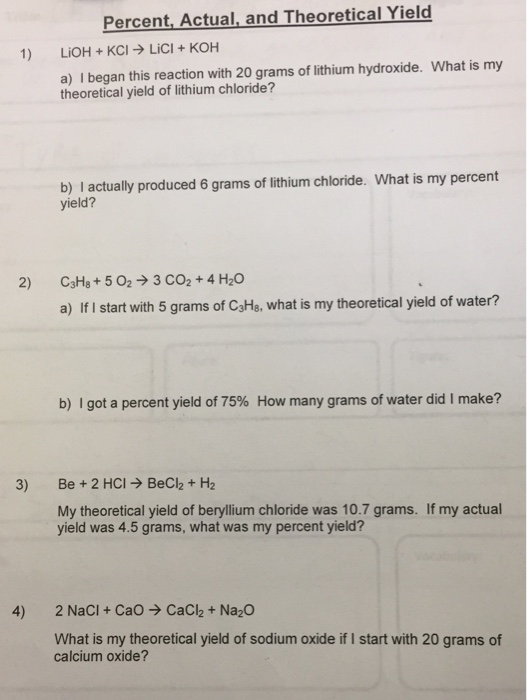
B I actually produced 6 grams of lithium chloride. The actual yield is the amount of product that is actually formed when the reaction is carried out in the laboratory.

The actual yield is the amount of product that is actually formed when the reaction is carried out in the laboratory.
Percent actual and theoretical yield. Theoretical actual and percentage yield. The maximum possible mass of a product that a chemical reaction can make. It is calculated using molar ratios.
The actual yield is the amount of product that is actually formed when the reaction is carried out in the laboratory. The percent yield is the ratio of the actual yield to the theoretical yield expressed as a percentage. 1291 Percent Yield Actual Yield Theoretical Yield 100.
Actual Theoretical and Percent Yield. There are so many types of yields in chemistry. In this video Ill go over all three that youre expected to know.
Actual yield theoretical. Amounts of products calculated from the complete reaction of the limiting reagent are called theoretical yields whereas the amount actually produced of a product is the actual yield. The ratio of actual yield to theoretical yield expressed in percentage is called the percentage yield.
Percentyield actualyield theoreticalyield 100. Percent Actual and Theoretical Yield 1. LiOH KCl LiCl KOH a.
I began this reaction with 20 grams of lithium hydroxide. What is my theoretical yield of lithium chloride. I actually produced 6 grams of lithium chloride.
What is my percent yield. C 3H 8 5 O 2 3 CO 2 4 H 2O a. If I start with 5 grams of C 3H 8 what is my theoretical yield of water.
I got a percent yield of 75 How many grams of. And my actual yield of titanium II oxide is 22 grams. 1375 theoretical yield is 160 grams students should recognize that this is a trick question designed to see if they know that 100 is the highest yield possible.
The ratio between actual yield and theoretical yield is most often given as percent yield. Percent yield Mass of actual yield Mass of theoretical yield x 100 percent How to Calculate Theoretical Yield Theoretical yield is found by identifying the limiting reactant of. About Press Copyright Contact us Creators Advertise Developers Terms Privacy Policy Safety How YouTube works Test new features Press Copyright Contact us Creators.
View Kami Export - Percent Actual Theoretical Yield Practicepdf from CHEMISTRY 1 at Lakota West High School. Percent Actual and Theoretical Yield 1 LiOH KCl LiCl KOH a I began this. The difference between the theoretical yield and the actual yield is known as the percentage yield.
Calculating the percentage yield and actual yield is quite simple. We must use the equation below. Percentage Yield Actual Yield Theoretical Yield 100.
The actual yield is the amount of product that is actually formed when the reaction is carried out in the laboratory. The percent yield is the ratio of the actual yield to the theoretical yield expressed as a percentage. 861 Percent Yield Actual Yield Theoretical Yield 100 Percent yield is very important in the manufacture of products.
Percent Actual and Theoretical Yield. 1LiOH KCl LiCl KOH. A I began this reaction with 20 grams of lithium hydroxide.
What is my theoretical yield of lithium chloride. B I actually produced 6 grams of lithium chloride. What is my percent yield.
3 H 8 5 O 2 3 CO 2 4 H 2. Oa If I start with 5 grams of C. 3 H 8 what is my theoretical yield of water.
Percentage Yield Actual YieldTheoretical Yield x 100 3 worked out examples of how to find the actualpercentage yield 1 For the balanced equation shown below if the reaction of 192 grams of O 2 produced 676 grams of H 2 O what is the percent yield. C 7 H 16 11O 2 – 7CO 2 8H 2 O. Based on that value you can find the percentage yield by using the ratio of the actual yield and the theoretical yield.
The formula for calculating the percent yield is. Percentage yield mass of actual yield mass of theoretical yield 100. Lets assume that you obtained an actual yield of 850 grams.
Then the percent yield would be. The percentage yield is the ratio between the actual yield and the theoretical yield multiplied by 100. It indicates the percent of theoretical yield that was obtained from the final product in an experiment.